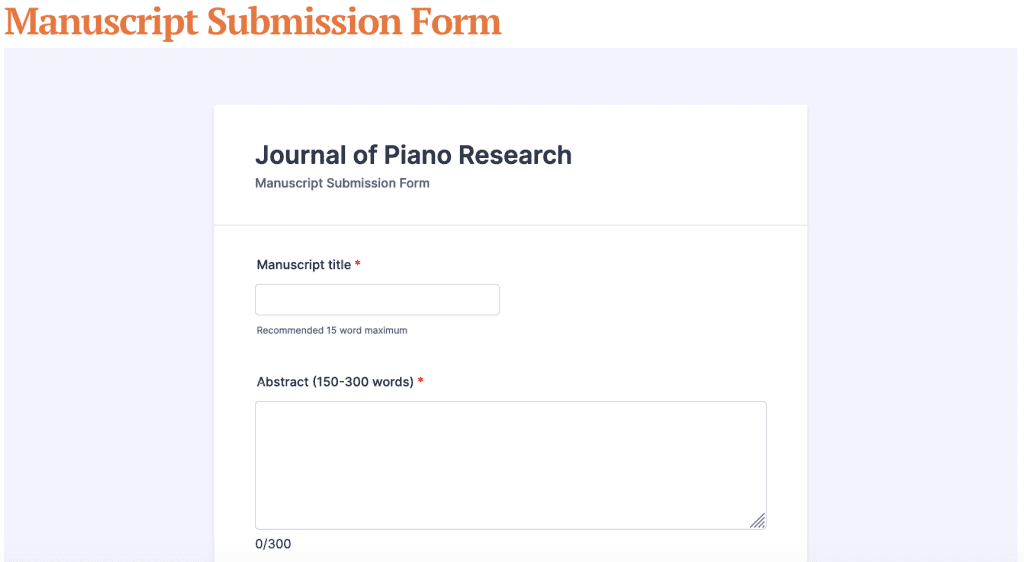We would like to thank Carla Salas-Ruiz for this contribution on writing articles for research publications such as the Journal of Piano Research. Learn more about the Journal of Piano Research by clicking here.

Writing, akin to music, provides a platform for self-expression. It also fosters critical thinking and enables us to articulate diverse perspectives, integrate information, and contribute to the advancement of our discipline. Yet, it’s common for many of us to feel a bit lost, unsure of where to even start. Have you ever found yourself facing a blank page, unsure of what to write or how to transform your project or research study into a compelling and engaging work? I have experienced this scenario several times. However, it wasn’t until I drew parallels between piano practice, lesson planning, and writing that a breakthrough occurred. I am excited to share these connections and encourage you to view academic writing as an art form for which you already possess all the necessary tools. Now is the time to leverage these tools and recognize writing as a creative exploration, where intentional choices and practice yield inspiring outcomes, similar to performing a piece or teaching a lesson.
Engage with Others’ Work
When practicing any musical piece, it’s crucial to grasp the composer’s expressive ideas and the essence of the composition to shape the interpretation effectively. To do this, we listen to recordings from other performers and study the musical language of the composer throughout their repertoire. Similarly, in writing, the initial step involves gathering exemplary articles from various sources such as journals, magazines, books, and other publications to identify essential elements like structure, language usage, and coherence. Deconstructing these articles, akin to dissecting a musical composition into sections and phrases, facilitates targeted writing practice. Analyzing the author’s intentions behind effective writing serves as a guide in crafting our roadmap. Additionally, extensive reading enriches our understanding and fuels creativity by exposing us to diverse viewpoints and encouraging critical thinking.
Craft Your Concept
Having learned from the insights of fellow writers, now is the ideal time to establish a method. This is similar to creating a practice log, focused solely on the concepts pertinent to your topic. During this phase, your reading should be targeted towards understanding existing discussions relevant to your chosen idea. It is essential to adopt a systematic approach, meticulously extracting key concepts from authors and documenting them methodically. I recommend constructing a table with columns for the source, author’s name, key quotes, year of publication, and page numbers.
After completing your reading journey, it is crucial to define your idea or research question through discussions with peers, similar to seeking feedback on a musical composition. Sharing your ideas with others can be tremendously beneficial, as they serve as a sounding board, potentially providing invaluable clarity to your thoughts. For instance, during my time in graduate school, my focus was on studying motivation. However, given the extensive literature surrounding the concept, it was only upon encountering the theory of Interest Development1 that I could delineate the scope of my idea and purposefully devise a roadmap to satisfy my curiosity. This process was greatly facilitated by continual discussions with colleagues, friends, and professors.

Develop a Method
With our ideas taking shape, we transition into methodological design, akin to selecting the appropriate techniques for musical expression. This time is about crafting a research question and defining a plan to answer that question. Establishing a robust research question is imperative, as it serves as a guiding beacon amidst the myriad of available methodologies, including quantitative, qualitative, ethnographic, historical, and/or philosophical approaches. Developing a method involves meticulously outlining the research design, methods, and techniques employed to satisfy your curiosity. It will outline your plans for data collection and analysis. In an academic context, this comprehensive plan encompasses critical decisions about how we chose participants or composers we’ll study, what tools we will use to gather information, how we will analyze that information carefully, and what conclusions we will draw from it. We will also look closely at what the findings mean and how they add to what we already know, the ideas we are working with, and how they can be useful in our field. This thorough analysis involves looking at the results in connection with the questions we asked at the start and the big ideas we are exploring, while also thinking about what they might mean for other important areas. Collaboration could be key in this step. Just as we gather to play beautiful chamber music, collaborate with colleagues that may have additional knowledge in this area, approach them and develop your idea in a multidisciplinary way.
Create a Writing Roadmap
Creating an outline for presenting your writing is essential to maintain clarity and coherence throughout your work. Remember Step 1? This is where your grasp of writing structures and tendencies becomes invaluable in organizing your writing process effectively. Consider these questions to initiate an initial outline:
- What is your idea?
- What sparked your interest in it?
- What insights have other authors or performers shared?
- How did you approach your methodology?
- What data did you collect, and how did you analyze it?
- What were the key findings, and how do they contribute to our profession?
- Why is it important to disseminate them?
Ensure you iterate through several drafts and seek feedback from peers and mentors. Crafting a roadmap for written contributions ensures that our ideas are effectively communicated with clarity and impact, much like crafting engaging lesson plans or conducting focused practice sessions. Once you feel confident with your outline, begin writing without self-judgment; allow yourself to simply type! Stick to your outline, but don’t hesitate to make adjustments for better flow if needed. Much like practicing an instrument, this stage represents full engagement in practice: experimenting with specific strategies and refining particular sections.
Decide Where to Publish
Just as we can sense when our repertoire is ready for the stage, we also know when our written work is prepared to be shared. Whether through academic journals, book chapters, or magazines, sharing our work enhances communication skills, professional growth, and advances our field. Similar to selecting the ideal venue and format for a recital, deciding where to publish prompts us to find platforms where our contributions align well. After completing our written work and reflecting on “Step 1,” we can determine which journal or magazine best suits our work. There are research-specific journals as well as those catering to practitioners. Understanding the purpose of each publication can assist us in making this decision. In the music field, there are a number of journals, including Piano Magazine and the recently launched Journal of Piano Research. We should consider all options, and after reviewing previous research, we can gauge the expected contributions and target audience.
Recognizing writing as an art form encourages us to engage in a journey of creativity and purposeful expression. Through the process of exploration, refinement, and sharing, we achieve transformative musical and teaching outcomes. Just as musical performance brings compositions to life, as writers we can give vitality and resonance to our ideas, enriching our collective discourse and advancing our field.
Go to journalofpianoresearch.org/ to learn more about this new publication!
MORE ON RESEARCH
- WEBINAR: From Idea to Research: A Panel of Mentors Discuss How to Plan, Develop and Conduct your Project with David Rickels, Carla Davis Cash, and Ann Marie Stanley
- WEBINAR: Pedagogy Research: What’s in it for Teachers and Students? with Diana Dumlavwalla and Charlene Ryan
- MAGAZINE ARTICLE: What does research tell us about the learning process? by Rebecca Grooms Johnson
- WEBINAR: From Research to Publication with Pamela Pike, Andrea McAlister, and Craig Sale
- WEBINAR: Approaching Quantitative Research: A Clinic for Early-Stage Quantitative Projects with James Austin and Peter Miksza
- DISCOVERY PAGE: Journal of Piano Research: Interview with Pamela Pike and Alejandro Cremaschi
- PRESS RELEASE: Journal of Piano Research Invites Submissions
Not yet a subscriber? Join for only $7.99/mo or $36/yr.
notes
- Suzzane Hidi and K. Ann Renninger, “The Four-Phase Model of Interest Development,” Educational Psychologist 41, no. 2 (2006): 111-127.
